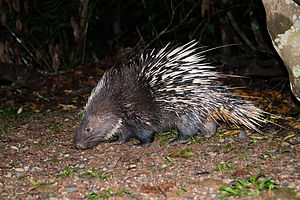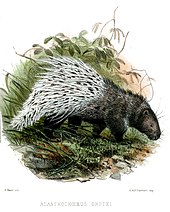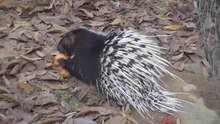Malay porcupine
| Malay porcupine | ||||||||||||
|---|---|---|---|---|---|---|---|---|---|---|---|---|

Malay porcupine ( Hystrix brachyura ) in Khao Yai National Park , Thailand |
||||||||||||
| Systematics | ||||||||||||
|
||||||||||||
| Scientific name | ||||||||||||
| Hystrix brachyura | ||||||||||||
| Linnaeus , 1758 |
The Malay porcupine or short-tailed porcupine ( Hystrix brachyura ) is a species of porcupine from the genus of real porcupines ( Hystrix ). It occurs in Asia from China to India and Southeast Asia.
features
The Malay porcupine reaches a head and trunk length of 55.8 to 73.5 centimeters, the tail length is 8.0 to 11.5 centimeters and the weight is between ten and eighteen kilograms. The hind foot becomes 75 to 93 millimeters long, the ear length is 25 to 28 millimeters. Like all real porcupines it is very big and heavy for a rodent. The eyes and ears are very small. The body of the animals is dark brown. The back and especially the trunk are covered with flat to square spines, the spines of the rear third are round and hard in cross-section. The spines in the central area of the back in the area of the spine are light brown at the base and have a white top, as a result of which they form light back stripes. The spines in the rear area are white at the base and tip and brown in between. The tail has conspicuous tubular spines with hollow ends that can be 20 to 30 centimeters long. The females have three pairs of side teats .
The skull length is 131 to 146 millimeters. The nasal bones are long and wide, they reach a length of more than 50% of the length of the skull. The genome consists of 2n = 60 chromosomes .
distribution
The Malay porcupine occurs in Asia from southeast China to Nepal to India and Southeast Asia. In India, it lives in Arunachal Pradesh , Sikkim , West Bengal , Manipur , Mizoram , Meghalaya and Nagaland , the distribution area also includes neighboring Bangladesh . In China, it includes parts of the provinces of Xizang (Tibet Autonomous Region), Guizhou , Yunnan , Sichuan , Chongqing , Guizhou, Hubei , Hunan , Guangxi , Guangdong , Fujian , Jianxi , Zhejiang , Shanghai , Jiangsu , Anhui , Henan , Shaanxi , Gansu as well Hong Kong and Hainan Island . In Southeast Asia, the distribution extends over Myanmar , Cambodia , Thailand , Laos , Vietnam , Singapore and the mainland of Malaysia . The species also lives on the island of Sumatra, which belongs to Indonesia, as well as on Borneo in the Malay and Indonesian parts as well as in Brunei . The height distribution extends to at least 1300 meters.
Way of life
The Malay porcupine lives on the ground in wooded areas and open spaces, where it digs large burrows in earthen walls or under rocks. The animals feed mainly herbivorous of roots, tubers, bark, green plant parts and downed fruit. The burrows are usually inhabited by family groups who go for food together at night. When the animals are threatened, they make a rattling noise with the spines of the tail, at the same time they grunt and stamp their legs. The spines cannot be thrown at the potential attacker, but the animals can strike with their tail tassels and thus drive the spines deep into the attacker's flesh.
Once or twice a year, after a gestation period of around 110 days, the females give birth to two or less often three young animals, which are very quickly and independently active as nests .
Systematics
The Malay porcupine is classified as an independent species within the genus of real porcupines ( Hystrix ), which consists of eight species in Asia and Africa. The first scientific description comes from Carl von Linné from 1758, who described the species in the 10th edition of his Systema naturae under the scientific name that is still valid today. Linnaeus stated Malacca in Malaysia as the place of origin .

(lithograph by Joseph Smit in the Proceedings of the Zoological Society of London , 1866)
Within the species, five subspecies are distinguished with the nominate form :
- Hystrix brachyura brachyura : nominate form
- Hystrix brachyura bengalensis
- Hystrix brachyura hodgsoni
- Hystrix brachyura subcristata
- Hystrix brachyura yunnanensis
Smith & Yan Xie 2009 also specify the island form Hystrix brachyura papae on the island of Hainan for the Chinese part of the distribution area , but are discussing the independent status.
Status, threat and protection
The Malay Porcupine is classified as Least Concern by the International Union for Conservation of Nature and Natural Resources (IUCN). This is justified with the large distribution area and its occurrence in numerous protected regions. It is relatively adaptable to habitat changes and the decline in stocks is relatively small. In Southeast Asia, the species is hunted as a source of meat, but the impact on populations through hunting is classified as minor. In South Asia there is a local threat of habitat loss resulting from the construction of dams and the expansion of cities and villages with their infrastructure.
supporting documents
- ↑ a b c d e f g h Andrew T. Smith: Malayan Porcupine. In: Andrew T. Smith , Yan Xie: A Guide to the Mammals of China. Princeton University Press, Princeton NJ 2008, ISBN 978-0-691-09984-2 , pp. 274-275.
- ↑ a b c d e f Hystrix brachyura in the Red List of Threatened Species of IUCN 2015-4. Posted by: D. Lunde, K. Aplin, S. Molur, 2008. Retrieved December 20, 2015.
- ↑ a b Hystrix brachyura ( Memento of the original from December 22, 2015 in the Internet Archive ) Info: The archive link was automatically inserted and not yet checked. Please check the original and archive link according to the instructions and then remove this notice. . In: Don E. Wilson , DeeAnn M. Reeder (Eds.): Mammal Species of the World. A taxonomic and geographic Reference. 2 volumes. 3. Edition. Johns Hopkins University Press, Baltimore MD 2005, ISBN 0-8018-8221-4 .
literature
- Andrew T. Smith: Malayan Porcupine. In: Andrew T. Smith , Yan Xie: A Guide to the Mammals of China. Princeton University Press, Princeton NJ 2008, ISBN 978-0-691-09984-2 , pp. 274-275.
Web links
- Hystrix brachyura onthe IUCN 2015-4 Red List of Threatened Species . Posted by: D. Lunde, K. Aplin, S. Molur, 2008. Retrieved December 20, 2015.

